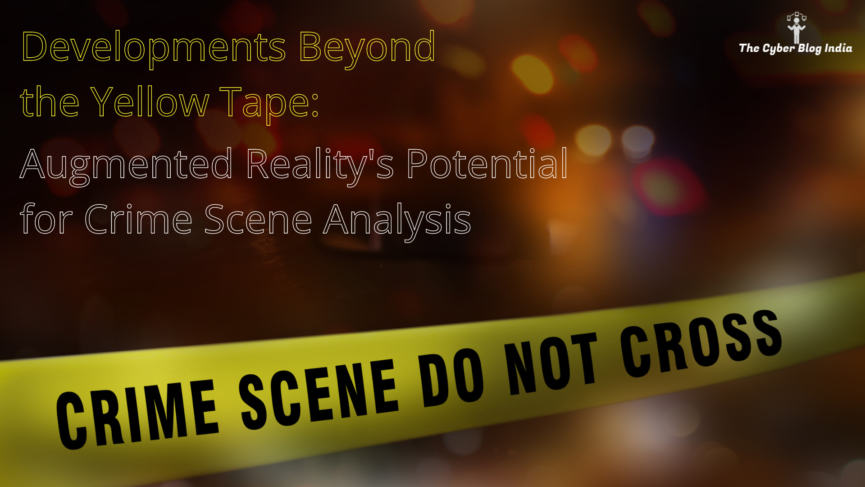Developments Beyond the Yellow Tape: Augmented Reality’s Potential for Crime Scene Analysis

Peter Arnold, the renowned crime scene specialist, famously referred to the crime scene as the “silent witness.” Analysing and understanding a crime scene is a vital skill that requires specific qualifications and expertise. Crime scene investigators (CSIs) possess these skills to conduct thorough criminal investigations and arrive at successful conclusions. However, traditional crime scene investigation techniques have limitations, leading to disparities between the current and desired outcomes of crime scene analysis.
This article examines technological advancements, particularly Augmented Reality (AR), which can help bridge this gap significantly. These developments include creating realistic 3D model reconstructions, virtual evidence overlays, remote expert collaborations, and specialist involvement. AR can enhance how CSIs perceive crime scenes, potentially revolutionising how crime cases are solved.
Potential of AR
AR is a cutting-edge technology that superimposes a highly immersive artificial environment onto the real world. Users can interact with virtual elements using tools like smartphones, tablets, AR glasses, and headsets, fundamentally changing how they perceive and interact with their surroundings. For example, surgeons can visualise a patient’s anatomy during surgery using AR headsets.
AR can also become essential in crime scene analysis. Investigation of the crime scene requires skill and precision in evidence collection and documentation. However, the complexities involved often lead to prolonged investigations, compromising the integrity and positioning of evidence. This is where AR technology comes in. Applications such as 3D modelling of the crime scene provide CSI professionals with virtual but realistic access to the crime scene and its evidence. This reduces the need to be physically present at the crime scene, minimising contact and potential damage to forensic artefacts.
Leveraging AR in Crime Scene Analysis
The emergence of AR presents an opportunity to revolutionise forensic science studies by offering a more dynamic and comprehensive approach to crime scene analysis. Some key applications of AR in this domain are:
- Quick and Time-sensitive: Crime scenes often contain volatile evidence requiring immediate preservation. Physical preservation may not always be feasible, but AR can capture and preserve these details virtually in real time. This ensures critical evidence is documented accurately before it can degrade or be disturbed.
- 3D Modelling and Crime Scene Documentation: Traditional methods like sketches and photographs have inherent limitations. Sketches can be subjective and time-consuming, while photographs often fail to capture spatial relationships effectively. AR enables real-time mapping and evidence collection, producing resolution 3D scans overlaid with annotations and measurements. This creates a more objective, detailed, and immersive record, enhancing the accuracy of scene representation.
- Improved Evidence Gathering: By using AR overlays, investigators can highlight potential evidence locations that the naked eye may miss. This expedites evidence collection while reducing the risk of contamination and allows for real-time documentation of the evidence collection process.
- Visualisation: Forensic experts can use AR to visualise the dynamics of a crime scene, such as bloodstain patterns, bullet holes, or potential movements of suspects within the crime scene. This helps investigators test hypotheses, identify inconsistencies, and better understand the sequence of events. The possibility of presenting AR reconstructions in a courtroom remains a grey area.
Challenges and Limitations
AR is still relatively new and developing, particularly in the context of crime scene forensics. Therefore, it poses certain unaddressed challenges and limitations before its potential implementation and acceptance. Some of these challenges are:
- Technical
- Integrating AR into forensic workflows necessitates technical expertise that CSIs may lack. Comprehensive training programmes are essential but can be time-consuming and costly.
- Seamless integration into existing workflows requires adaptation. This can be a significant hurdle for small-scale or underfunded laboratories.
- Implementation Cost
- Implementing AR will require specialised hardware and software, which will pose financial challenges for small-scale labs. Funding and resource allocation will be crucial for widespread adoption.
- Ethical Considerations
- AR involves capturing sensitive crime scene data, which may raise concerns about the privacy of individuals involved in the case. Imagine an AR overlay highlighting a victim’s past injuries or medical history. Hence, it is essential to mitigate the potential for misuse by establishing well-defined policies and procedures.
- AR systems rely on algorithms and data sets to operate. However, these algorithms may acquire biases from their training data. This could result in situations where an AR system emphasises certain types of evidence over others, potentially influencing the investigation unfairly. Addressing this concern is crucial to keeping the forensic process fair and unbiased.
Conclusion
AR stands as a ground-breaking and innovative technology with great potential to overcome current challenges within the forensic landscape. It shows promising results in driving innovation and efficiency in the field. It can significantly revolutionise how investigators analyse crime scenes by transforming documentation, improving evidence collection, and offering a new perspective for scene reconstruction. However, to fully realise these advantages, addressing technical, financial, and ethical challenges is crucial. Ethical issues surrounding data privacy demand the utmost attention as they involve sensitive information and data related to the crime. Establishing a legal and ethical framework will ensure the responsible use of AR.
As we contemplate the advantages, we must ask ourselves — how can we leverage this technology to its fullest potential while maintaining ethical standards and privacy? If there is a dispute between privacy rights and the implementation of technology ensuring justice, which will proceed? Should authorities ensure the associated costs are feasible for the players with financial subsidies and aids? The answer lies not just in the technology itself but our intentions and how we choose to wield it.
